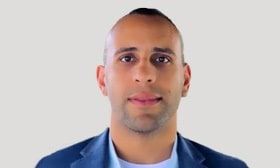Insights
Diverse Hiring Is Just the First Step in Building a Culture of Inclusion

Inclusion only happens if everyone contributes.
January 2023

Anthony Almanzar
Vice President, Program Manager,
SSGA Application Technology Solutions Group (ATS)
As companies increasingly recognize the importance of inclusivity in building diverse teams and retaining talent, it’s important to address what inclusivity truly means in practice.
Consider my own experience with State Street’s culture of inclusion. I’ve been offered a seat at the table in key decision-making processes within my business unit, and I’ve also contributed ideas to enterprise-wide transformation efforts. As a result, I know my inputs are valued, and I have been able to see the impact of my work in real time.
What’s more, as I’ve seized these opportunities, I’ve felt empowered to candidly connect with colleagues at all levels of the company. Just the other day, I ran into our global chief investment officer in the cafeteria, and we had a brief chat about a recent conference she attended in Washington, D.C.
Moments of personal connection like these are what I mean when I talk about inclusion: the interactions that help people feel comfortable, like when a colleague calls you by name and acknowledges you when they see you outside of your day-to-day work environment. Inclusionary practices are key to helping employees understand how their work fits in with the company’s vision, and how they can grow with the organization.
This demonstrates that a company’s diversity goals are more substantive than simply hiring candidates who can help them meet those numbers before moving on to the next priority. Without those efforts to make diverse new hires feel included as valued team members, retention can suffer, as can a company’s reputation.
By contrast, a company that follows through on building an inclusive culture can attract a wider array of candidates and clients, which can in turn help achieve stronger business results.
Developing inclusivity
Adopting an inclusive strategy can feel challenging at first, but it gets easier as it is implemented more frequently and effectively. Inclusivity is a responsibility for everyone, at every level of the organization, and it can be difficult to achieve in a hybrid model. At the senior level, we’ve recognized the importance of creating inclusion opportunities through teambuilding and responsibility-sharing. We have senior leaders traveling to India, Australia and other regions to meet with those teams, and increasingly, we are flying people into Boston so they can engage with other team members face-to-face. That personal connection is critical: When the team experiences that in-person interactivity with their colleagues, it keeps them engaged, and motivates them to keep pushing for more opportunities and responsibilities.
It’s important for everyone to understand that inclusivity work is always going to reveal opportunities for improvement. Companies that pay attention to what works and what doesn’t, and then request and listen to feedback from diverse employees, can self-correct any errors and develop a more inclusive culture.
This is why initiatives like State Street’s 10 Actions Against Racism and Inequality and 1,000 Conversations – a component of Action No. 3, in which employees at all levels are encouraged to engage in conversations about creating environments of belonging and inclusion – have been so fruitful. In adopting the 10 Actions, we've established a system of accountability around issues of inclusion: Every location assigns one or two national committee leaders who are responsible for planning programs and allocating resources. This has proven to drive diversity, representation and building equity in the organization. The end result is a fundamental transformation in the ways we interact with each other, ensuring that every employee can play a role in prioritizing inclusion.
Taking action
Diversity and inclusion efforts mean taking into account all of the ways people differ — race, gender, ability and more — and sparking dialogue and connection to better understand one another. For example, our disability inclusion efforts, including the work of our Global Disability Taskforce and the Disability: IN pledge adopted in 2020, have created a more inclusive environment for hiring, training and providing access for staff with disabilities.
Employee resource groups, such as the Professional Women’s Network, Veterans Network and the Latin American Professionals Group (which I chair), continue to be valuable resources for building affinity networks between employees. Currently, we are working to revamp the LAPG’s mentoring program to expand the range of employees who can benefit from it, from entry through VP-level. I will always appreciate the time my mentor devoted to my professional development. She helped me get to where I am now, and we see this mentorship program as providing that same kind of personalized and meaningful guidance to help each individual get to the next level.
At the end of the day, we achieve inclusion by building relationships and interacting with colleagues in ways that make them feel like their contributions matter. It’s a never-ending job — and one that I believe makes us better every day.
Related Insights



